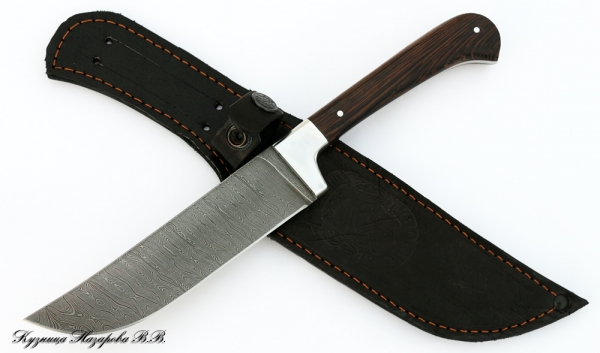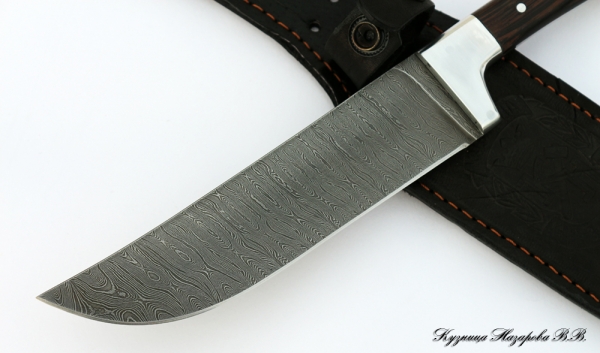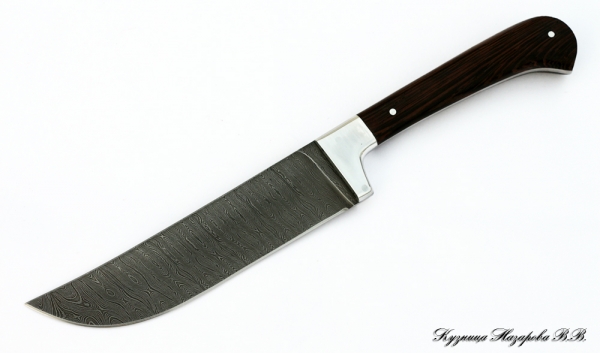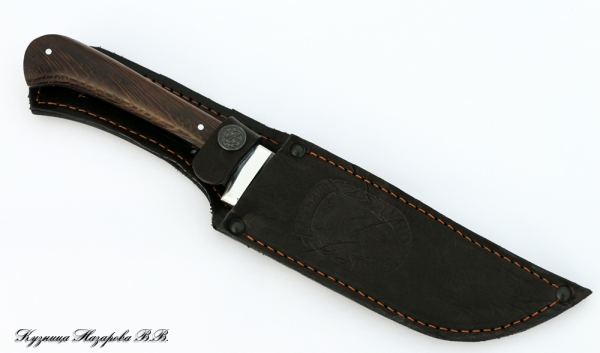- Главная
- Online knife shop
- By type of steel
- Damaskus knives
- Knife Uzbek Damascus all-metal wenge
Knife Uzbek Damascus all-metal wenge
Knife Uzbek Damascus all-metal wenge
- Blade steel tipeDamascus
- Материал рукоятиВенге
- Lengtn blade (os)150 mm
- Witdth blade (os)36 mm
- Толщина клинка3.2 mm
- Lengtn handle (os) 130 mm
- Hardness (HRC)62
- Product weight, gram200
- SheathLeather
- КонструкцияФиксированные
- Форма клинкаTrailing point
Detailed analysis of the properties and features of the knife
Blade steel — Damascus (hardness 62 HRC): The blade is made of Damascus steel with an outstanding hardness of 62 HRC, a high—strength material known for its excellent sharpening ability and pronounced decorative effect. Damascus combines layered structures, which makes this knife not only a working tool, but also a collector's item. The hardness of 62 HRC ensures a long service life of the cutting edge and resistance to wear even under heavy use, but requires careful handling to avoid chipping on very fine cutting.
The handle is wenge, all—metal construction: The handle is made of natural wenge wood, which has a dense texture and a deep, noble shade. Wenge is resistant to moisture and mechanical stress, is not susceptible to cracking and deformation. The all—metal construction gives the knife additional strength and ensures a secure hold even in difficult conditions - the knife lies securely in the hand, and due to the wenge texture it does not slip in either dry or wet palms.
The shape of the blade is the Trailing Point: The classic oriental shape of the Trailing Point is characterized by a curved, high-raised tip line. This geometry allows the knife to perform excellent cutting and milling work, especially on food, meat and fish. The blade length of 150 mm and width of 36 mm provide excellent maneuverability and ease of cutting, while the thickness of 3.2 mm provides a balance between strength and durability.
Resistance to moisture and corrosion, maintenance: Damascus steel has moderate resistance to moisture — due to its layering, Damascus is less susceptible to corrosion, but it does not belong to stainless steels. To preserve the appearance and operational properties, it is recommended to wipe the blade dry after each use and periodically treat it with protective oil. The wenge handle is resistant to moisture, but also benefits from treatment with special wood oils.
Wear resistance and easy maintenance: The high hardness of the blade retains its sharpness for a long time — the knife will have to be sharpened less often. However, to restore sharpness, you will need a high-quality abrasive, preferably a system with control of the sharpening angle. Care of the handle is minimal, it is enough to avoid prolonged contact with water and dry the knife after use.
Scope of application, advantages and limitations
- Optimal tasks:
- Cuisine: thinning, cutting and slicing meat, fish, vegetables — the knife is especially good where a clean, long cut is important and the ability to separate meat from bone or skin finely and neatly.
- Hiking, hiking: due to its strength and all—metal construction, it is resistant to loads, but requires caution during extreme work.
- Collectibles: the combination of damask and wenge, as well as handmade, endow the product with artistic value and uniqueness.
-
Restrictions:
- It is not recommended for heavy woodwork (chopping, opening bones, cracking) — chipping is possible due to the high hardness and thin edge. It is not intended for use in conditions of prolonged exposure to moisture or aggressive environments (salt water, etc.) — it requires regular maintenance.
- Not the best choice for batoning and rough hiking tasks — prefers a delicate cut.
Unique features and advantages
- The unique Damascus steel pattern gives each piece its own personality.
- Manual assembly and processing emphasize status and attention to detail.
- The all-metal construction and wenge enhance practicality and visual value.
- The eastern shape of the blade (Trailing Point) is a tribute to the historical heritage and culture of Central Asia, providing excellent handling of the cutting edge.
Care recommendations
- Wipe the blade dry after each use, lubricate it with a light protective oil for long—term storage.
- Do not wash in the dishwasher and do not leave it wet for a long time.
- The wooden handle should be periodically treated with oil to preserve the structure and prevent cracking.
- Sharpen only with high-quality abrasives, avoiding overheating of the steel.
Conclusion and brief recommendation
This knife is an ideal choice for connoisseurs of oriental cooking, lovers of fine tools and collectors who value not only functionality, but also uniqueness of appearance. It will perform well in the kitchen or in camping conditions, where a clean cut and high sharpness are needed. For chopping or rough work, you should choose another tool. If you are looking for a knife with character, pronounced style and high cutting ability, this model will be a worthy addition to your collection or kitchen arsenal.
- Categories:
- Damaskus knives
- Uzbek knives








